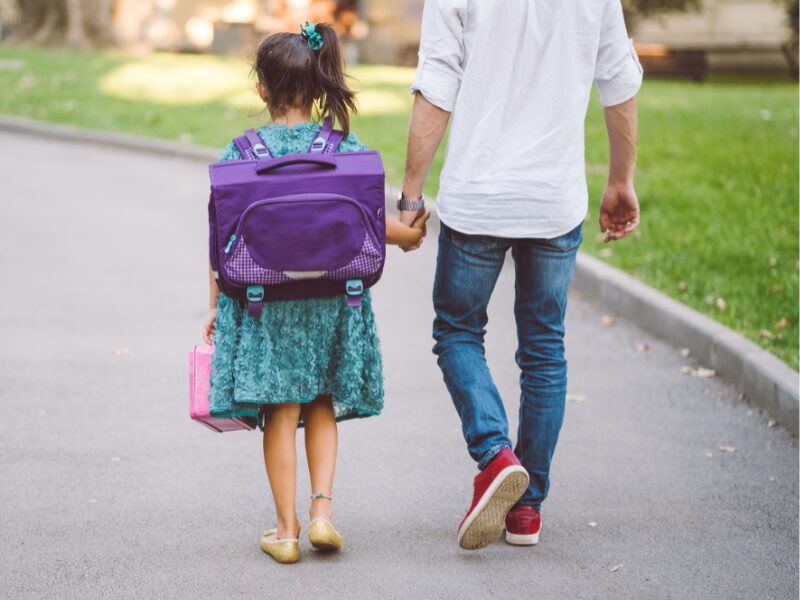While it may feel like summer break is still on, but the countdown clock is ticking and back to school season is just around the corner.
And as summer break ends, parents of children who have experienced trauma may face unique challenges in preparing for the new school year.
HopeConnect™ offers you the following guidance to help transition from summer break to the new school year more smoothly and positively — for both you and your child. Here are some ways to help your child get ready to go back to school.
This article is the first in the Thrive Back to School Collection, a six-part series designed to equip you with the skills and strategies you need to start this fall semester off on the right foot. Head to our blog to learn more.
Help Children Anticipate What to Expect
Back to school season is a time of transitions. So, planning ahead with your child is critical to ensuring a smooth transition. Here are a few tips and a link to our Back To School Checklist to help you start the transition from summer break a whole month before.
- Discuss with children any anxieties they have about going back to school.
- Walk them through what their schedules will be and where you will drop them off and pick them up.
- Provide any information you might have about their teachers.
- Help them to pick out clothes and schedule their haircut
- Talk about their favorite school lunch choices.
- Schedule their haircut
- Review any summer reading or other assignments due the first day of school
- If possible, physically walk the space with your child and do a “first day trial run”
Establish Routines
Creating a structured routine is crucial for children who have experienced trauma. Visual charts can be effective in reducing anxiety and providing a sense of predictability, especially during back to school season.
Work with your child to create a visual chart outlining daily routines, including:
- Wake-up time
- Breakfast
- School hours
- After-school activities
- Homework time
- Once you have the following information planned in your chart, here are some additional ways you can make your back to school routine extra special.Include specific times for each activity on the chart to provide clear expectations.
- Involve your children in creating the chart to give them a sense of control and ownership.
- Make the chart fun with vibrant colors.
- Ask your children to choose a fun, upbeat Christian song to wake-up to.
- Create a playlist with their favorite songs. Need some help to kick things off? Ask your child about their favorite Christian artist.
Prioritize Physical Activity
Dancing to the tunes mentioned above helps with this point. Exercise plays a vital role in managing stress and improving mood for children who have experienced trauma. It can be beneficial to incorporate physical activity into your child’s back to school routine.
- Encourage regular physical activity, such as dancing or walking, they can easily do with you, which can boost endorphins and serotonin levels.
- Maintain existing exercise routines or introduce new ones before school starts.
- Consider family activities that incorporate movement to make exercise more enjoyable, like jumping jacks or playing “Simon says”.
- Try homework time standing up or on the floor if your child needs movement to help with regulation.
Celebrate the First Day
Make the first day back to school a special event. You can use the following festive ideas for more than just the first day. Consider adapting them to each month of the school year to celebrate a new month of learning.
- Decorate the front door with a “First Day of School” banner.
- Create a first-day-of-school journal that your child can personalize.
- Prepare a special breakfast, such as alphabet or heart-shaped pancakes.
Pray With Your Child
Transitioning back to school may evoke a lot of mixed feelings for your child. So, take a moment to pray with them, too. If they feel comfortable leading the prayer, ask them to lead. If not, kick off the conversation with Jesus.
Whether it’s a brief prayer of faith as small as a mustard seed described in Mark 4:30-32 or great faith as the Centurion showed in Matthew 8: 5-10, praying with your child helps them give their thoughts to Christ. He can help them be strong and courageous because in Joshua 1:9 He promises to be with them always.
Stay tuned next week for Transitioning Back to School (Part 2) offering additional fun tips on how to guide your child into their new school year.
KEY TAKEAWAY
The back to school season can cause a lot of stress and anxiety for children — especially those who have experienced trauma. Help your child get comfortable going back to school by using these strategies. And remind your child that no matter what happens, God is with them.
“This is my command—be strong and courageous! Do not be afraid or discouraged. For the LORD your God is with you wherever you go.” ~Joshua 1:9 (NLT)
APPLICATION
Does your child need a little extra encouragement for the back to school season? Read “Put on Your Faith Eyes!” to them before the first day. This interactive Bible story reminds children that God is with us whenever we walk into new situations or places — no matter how scary they might be.
Find this game and more now in the Everyday Moments™ activities collection






